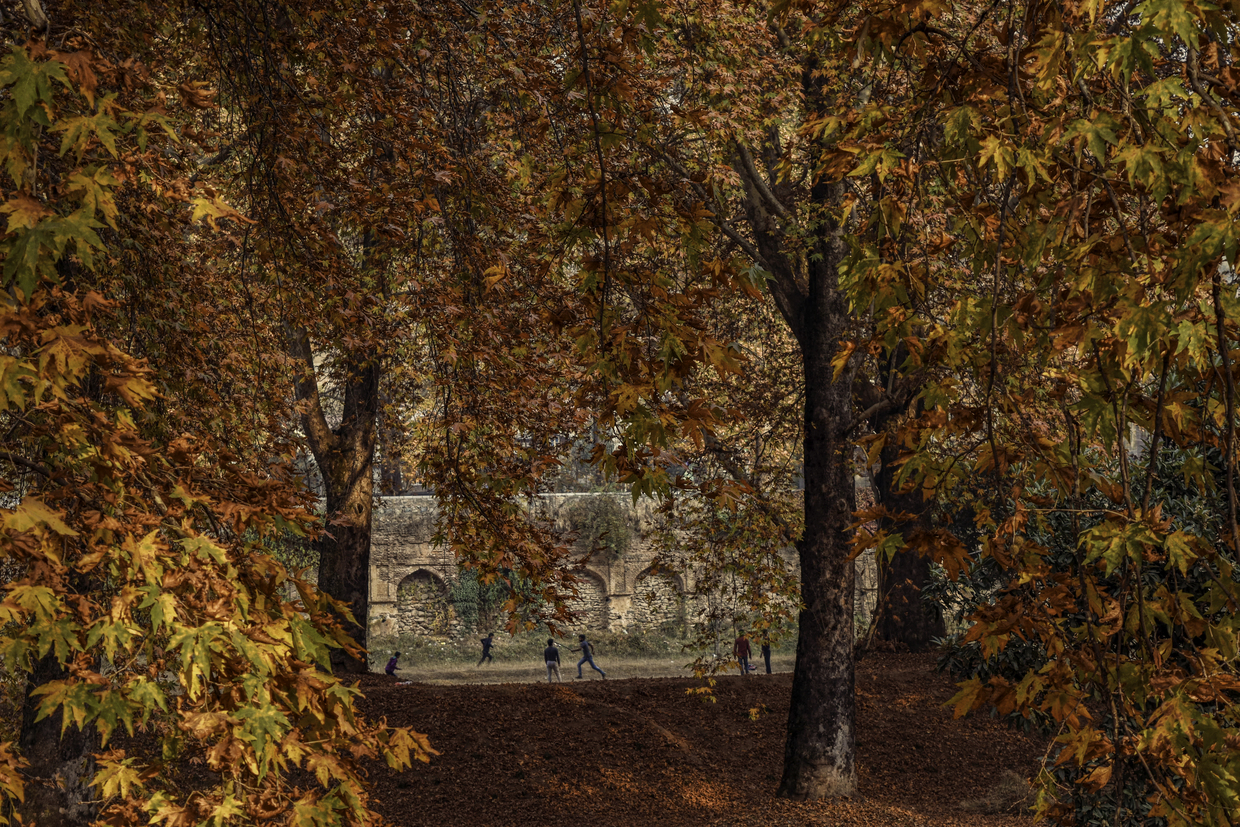Chinar: Indian legend that inspired poets and emperors is withering away

The Chinar is fast disappearing. It is the heritage tree (a deciduous Platanus Oriental) of Kashmir, India’s northern border region. It is linked to Kashmir’s romantic splendor, spiritual vibrancy, ecology, politics, literature, and much more. But due to urbanization and unplanned development, many have been cut down, setting alarm bells ringing.
This has caused anxiety among environmentalists, heritage activists, cultural commentators and civil society actors. Yet they refuse to surrender hope and maintain a desire to preserve the Chinar for posterity.
Experts cite official apathy and public greed as the two major factors behind the diminishing numbers of Chinars. According to Jammu & Kashmir’s (J&K) floriculture department, there are currently about 35,000 Chinars left. From an estimated 50,000 in the 1980s and 42,000 in the 1990s, the number of plane trees has drastically reduced. These are official numbers.

Independent estimates put the number of Chinars at less than 20,000. At least one-third of these trees have been diagnosed as damaged or diseased in a census conducted by the Forest Research Institute (FRI) in 2023.
Muhammad Sultan Wadoo, former chief conservator of the J&K forests department, in his book The Trees of Our Heritage records that only 17,124 Chinars are left in Kashmir, of which more than 700 are chopped down annually.
Origins of the Chinar
Imagining Kashmir’s picturesque landscape, without visualizing the Chinar (or the plane tree) is akin to considering Britain, France, Germany and Russia without humor, wine, automobiles and Red Square, respectively. Chinar is Kashmir’s romantic address for nature lovers, poets and art enthusiasts.
Originally a Persian word and also spelt Cinar, Chinar roughly means ‘flame’. In local parlance, it is called Booune while its botanical name is Platanus Oriental. The Chinar has become Kashmir’s fitting reference point as it bears witness to the many tragedies and triumphs of the region’s past and present.

For myriad reasons, including the valley’s robust religious, cultural and climatic resemblance and literary linkages, Kashmir was once referred to as Iran-e-Sagheer (Prototype of Iran or Little Persia). In Iran’s well-known city of Isfahan, Chinar trees are not scarce, while some refer to the Iranian capital, Tehran, as the City of Chinars. The place of origin of this mighty deciduous tree of the Platanaceae family is historically linked to Greece from where it is supposed to have spread to parts of Europe, Central Asia, Tehran and Isfahan.
Plane trees are usually found inside the compounds of famed shrines and gardens of the Valley. One of the oldest Chinar trees can be found near a mosque in Chattergam, in central Kashmir’s Budgam district, while another one is in the Padshahi Bagh in south Kashmir’s Bijbehara town.
The Chinar tree standing tall in Chattergam is believed to be over 600 years old while other trees are said to be around 300-400 years old.
Sufi scholars and saints and Islamic preachers who arrived in the Valley centuries ago from parts of Central Asia and Persia considered the tree sacred. The oldest Chinar in central Kashmir is said to have been planted by the revered Sufi Saint Syed Qasim Shah. The tree is about 15 meters tall with the potential to reach about 19m, according to In the Shade of Chinar, by the Jammu and Kashmir forest department.

‘Che–Naar-Ast’
Historians record that the Mughals ordered the planting of over a thousand Chinars along the embankment of the Dal Lake and Naseem Bagh in Kashmir’s summer capital Srinagar; in Anantnag, Kokernag and Bijbehara in southern Kashmir; and in Budgam in central Kashmir. They say the Mughal emperor Jehangir gave this name (Chinar) to the tree in Kashmir.
The legend has it that an onlooker once saw the leaves of the Chinar turned a yellow radiant red, exclaiming “Che-Naar” or “Che–Naar-Ast” in Persian, meaning “What flame” or “What blaze is it?”

From this onlooker’s curiosity about a possible fire, Jahangir is believed to have given the name Chinar to the royal tree. Another popular legend is that Emperor Jahangir himself shouted “Chi-Naar.”
King Akbar, in 1586, is said to have ordered the planting of about seven hundred and fifty plane trees on the shores of the famed lake and around the Hazratbal (Dargah) shrine in Srinagar.
The Mughals are also credited for being passionately involved in taking care of Chinars. The Mughals accelerated planting many Chinars in decorated Nishat, Shalimar and Harvan gardens (also known as the Mughal gardens), adding more flavor to the valley’s eye-catching scenery, which is marveled at in all seasons.

‘I will die, in autumn, in Kashmir’
New-age vocalists and musicians are often seen composing their creative beats while enjoying the shade of a Chinar or walking on its distinctive fan-shaped leaves that fall on the ground in late autumn.
During autumn, Chinar trees attract even more attention from the natives and visitors as the color of their leaves turns crimson-red from the original green. It is pleasing on the eye and inspires poets to write beautiful verses using the Chinar tree, the varying hues of its leaves and their seasonal shedding as metaphors for life experiences.
With their strokes of genius, the artists put colors on the canvas to create memorable paintings of the tree, its leaves and their multiple shades. The Chinar is a dominant motif for papier-mâché artists and is also found in decorative walnut woodworks.

Thanks to its majestic Chinars, the region looks even more dazzling in autumn. Aesthetically pleasing Chinars are one of the major attractions for natives and tourists alike.
Agha Shahid Ali, a renowned Kashmiri-American poet, in one of his epic poems The Last Saffron wrote: “I will die, in autumn, in Kashmir.” Ali died young at the age of 52, in Amherst, Massachusetts.
Racing against Time
Zareef Ahmad Zareef, a prominent cultural commentator and satirist-poet based in downtown Srinagar, is the epitome of hope, courage, and conviction. Usually, his satirical one-liners leave audiences – both young and old – in stitches and his acts of kindness offer hope for a better tomorrow. Zareef has kept the hope alive for a sustainable future by planting Chinar trees across every nook and cranny of the valley.

About two decades ago, the idea of preservation took shape in the form of the Save Chinar initiative led by the octogenarian activist. With time, Zareef’s program gathered momentum and received support from Kashmir’s once vibrant civil society. According to Zareef, their efforts ensured the local government could no longer afford silence or inaction. It immediately formed a separate Chinar Development Authority.
“Chinar is our cherished treasure. Kashmir’s soil is fertile. The tree reflects our conscience. It is our moral duty to save Chinars by planting Chinars,” Zareef told RT.
Though he laments how urbanization, expansion, unplanned construction and pollution pose a significant threat to the existence of this iconic tree, he says hopelessness and helplessness are not the solution. He underscores the need to intensify the movement to preserve Chinars for posterity.
In this noble endeavor, the activist is not alone. As part of the Zareef-led ‘Save Chinar’ (Booune Bachav Tehreek in Kashmiri) movement, civil society activists, environmentalists and concerned citizens have planted plane trees in multiple locations to preserve their rich legacy.

Abdul Hamid Bhat, a 55-year-old entrepreneur and environment activist, has set a tough goal for himself. Bhat is on a mission to plant one million trees across Kashmir by 2030. “Besides Deodar and other trees, I have planted about a thousand Chinars in various parts of Kashmir, mostly in rural geography,” Bhat told RT, adding “Chinar is our identity and it has to be kept intact.”
Dr. Sheikh Ghulam Rasool, another environmental activist, says the realistic target for each activist is to plant about 100 trees annually to preserve the tree for “our coming generations.” He states further: “Unfortunately, Chinars have become primary victims of unplanned construction and town planning. But we, as comrades of Zareef Ahmad Zareef, are not giving up. We are a part of his ‘Save Chinar’ initiative.”
According to the activist, about 20 species of birds find protection and a home near Chinars. According to another expert, besides providing shade to people sitting under it in scorching heat during summer months, the Chinar is “an oxygen-producing machine generating 120 liters of the lifesaving oxygen annually.”

No doubt, Chinars are fighting a battle for survival. However, people like Zareef and environmental activists like Abdul Hamid Bhat are refusing to give up.
Experts say that it takes between 30 and 50 years for the plane tree to attain mature height and around 100-150 years to grow to its full strength and size. A Chinar can grow up to 30 meters or even more with a girth exceeding 150 meters. Longevity is one of its features.
That is perhaps why Dr. Mohammad Iqbal aka Allama Iqbal, a renowned poet and philosopher, in one of his verses used the Chinar as a metaphor for Kashmir’s consciousness:
“Jis khaak ke zameer mein ho aatish-e-chinar
Mumkin nahin ki sard ho woh khaak-e-arjumand”
(The dust that carries in its conscience the fire of Chinar, It is impossible for the celestial dust to cool down)














